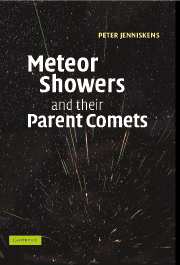Book contents
- Frontmatter
- Dedication
- Contents
- Preface
- Acknowledgements
- Part I Introduction
- Part II Parent bodies
- Part III Young streams from water vapor drag
- 11 Forecasting meteor storms from what planets do to dust trails
- 12 Meteor storm chasing
- 13 Meteor outbursts from long-period comets
- 14 Trapped: the Leonid Filament
- 15 The Leonid storms
- 16 The Ursids
- 17 The Perseids
- 18 Other Halley-type comets
- 19 Dust trails of Jupiter-family comets
- Part IV Young streams from comet fragmentation
- Part V Old streams and sporadic meteoroids
- Part VI Impact and relevance of meteor showers
- Appendix
- Tables
- Index
- Units and constants
16 - The Ursids
from Part III - Young streams from water vapor drag
Published online by Cambridge University Press: 05 July 2015
- Frontmatter
- Dedication
- Contents
- Preface
- Acknowledgements
- Part I Introduction
- Part II Parent bodies
- Part III Young streams from water vapor drag
- 11 Forecasting meteor storms from what planets do to dust trails
- 12 Meteor storm chasing
- 13 Meteor outbursts from long-period comets
- 14 Trapped: the Leonid Filament
- 15 The Leonid storms
- 16 The Ursids
- 17 The Perseids
- 18 Other Halley-type comets
- 19 Dust trails of Jupiter-family comets
- Part IV Young streams from comet fragmentation
- Part V Old streams and sporadic meteoroids
- Part VI Impact and relevance of meteor showers
- Appendix
- Tables
- Index
- Units and constants
Summary
Shortly after the 1999 Leonid storm, Esko Lyytinen and I teamed up to tackle a longstanding mystery: why do Ursid showers (Fig. 16.1) tend to have outbursts when the parent comet is at aphelion? Parent comet 8P/Tuttle, like 55P/Tempel–Tuttle, is a Halley-type comet and the same techniques could be expected to work.
When we started the investigation, even the identification of the Ursids with 8P/Tuttle was in doubt. The Ursid meteors radiated from R.A. = 219.4°, Decl. +75.3°, slightly different from the predicted radiant at R.A. = 214.5°, Decl. =+74.4°. More importantly, the orbit of comet 8P/Tuttle is far from Earth's orbit, with a minimum distance of 0.095 AU on December 22. In order to intersect Earth's orbit, the meteoroids have to evolve significantly to smaller perihelion distances.
We discovered that the Tuttle meteoroids can get trapped in a mean-motion resonance just outside of that which traps the comet. Because the orbital periods of the meteoroids and the comet are different, the dust gradually moves away from the position of the comet and after about 45 revolutions, the dust lags by half an orbit. And, guess what, it takes that long for dust to wander into Earth's path.
16.1 The Ursid Filament
The first clue to the cause of the Ursid aphelion outbursts came in 1994, when I discovered that Ursids have perihelion outbursts as well.
Ilkka Yrjölä's radio-MS data (Fig. 16.2) showed strong Ursid activity with varying intensity from year to year. Highest rates had occurred just before the comet reached perihelion in 1994. These enhancements stood out from the other aphelion Ursid outbursts by being significantly broader and about a day wide. I then realized that one such outburst had been seen in December, 1982 by Jos Nijland and Hans Breukers of the Dutch Meteor Society. Word came that the 1994 Ursid outburst was spotted by visual observers in Japan.
- Type
- Chapter
- Information
- Meteor Showers and their Parent Comets , pp. 263 - 270Publisher: Cambridge University PressPrint publication year: 2006



